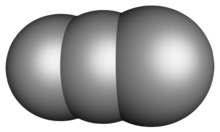
| |
| Names | |
|---|---|
| IUPAC name
Tricarbon
| |
| Systematic IUPAC name
1λ2,3λ2-propadiene | |
| Other names
Triatomic carbon[citation needed]
| |
| Identifiers | |
3D model (JSmol)
|
|
| ChemSpider | |
PubChem CID
|
|
| |
| |
| Properties | |
| C3 | |
| Molar mass | 36.033 g·mol−1 |
| Thermochemistry | |
Std molar
entropy (S⦵298) |
237.27 J K−1 mol−1 |
Std enthalpy of
formation (ΔfH⦵298) |
820.06 kJ mol−1 |
| Related compounds | |
Related carbon molecules
|
Diatomic carbon |
Except where otherwise noted, data are given for materials in their standard state (at 25 °C [77 °F], 100 kPa).
| |
Tricarbon (systematically named 1λ2,3λ2-propadiene and catena-tricarbon) is an inorganic compound with the chemical formula C
2(μ-C) (also written [C(μ-C)C] or C
3). It is a colourless gas that only persists in dilution or solution as an adduct. It is one of the simplest unsaturated carbenes. Tricarbon can be found in interstellar space and can be produced in the laboratory by a process called laser ablation.
YouTube Encyclopedic
-
1/5Views:1 896379 63250 420591 9071 071
-
Dicarbon monoxide
-
SO2 Lewis Structure - How to Draw the Lewis Structure for SO2 (Sulfur Dioxide)
-
How to Draw the Lewis Structure for C3H8 (Propane)
-
Lewis Structure of SO2 (sulfur dioxide)
-
Inorganic Chemical Nomenclature Part 1 Binary Compounds
Transcription
Natural occurrence
Tricarbon is a small carbon cluster first spectroscopically observed in the early 20th century in the tail of a comet by William Huggins and subsequently identified in stellar atmospheres. Small carbon clusters like tricarbon and dicarbon are regarded as soot precursors and are implicated in the formation of certain industrial diamonds and in the formation of fullerenes.
C3 has also been identified as a transient species in various combustion reactions.[1]: 218–220, plate 20
Properties
Chemical properties
The chemical properties of C3 was investigated in the 1960s by Professor Emeritus Philip S. Skell of Pennsylvania State University, who showed that certain reactions of carbon vapor indicated its generation, such as the reaction with isobutylene to produce 1,1,1',1'-tetramethyl-bis-ethanoallene.[2]
Physical properties
The ground state molecular geometry of tricarbon has been identified as linear via its characteristic symmetric and antisymmetric stretching and bending vibrational modes and bears bond lengths of 129 to 130 picometer corresponding to those of alkenes. The ionization potential is determined experimentally at 11 to 13.5 electronvolts.[3] In contrast to the linear tricarbon molecule, the C+
3 cation is bent.
Nomenclature
The systematic names 1λ2,3λ2-propadiene, and μ-carbidodicarbon, valid IUPAC names, are constructed according to the substitutive and additive nomenclatures, respectively.
In appropriate contexts, tricarbon can be viewed as propadiene with four hydrogen atoms removed, or as propane with eight hydrogen atoms removed; and as such, propadienediylidene or propanetetraylidene, respectively, may be used as a context-specific systematic names, according to substitutive nomenclature. By default, these names pay no regard to the radicality of the tricarbon molecule. In even more specific context, these can also name the non-radical singlet state, whereas the diradical state is named propadienediylylidene, or propanediyldiylidene, and the tetraradical state is named propedienetetrayl or propanetetraylylidene.[2]
See also
References
- ^ Gaydon, Alfred G.; Wolfhard, Hans G. (1979). "Detection of intermediate products". Flames: their structure, radiation and temperature (4th rev. ed.). London: Chapman and Hall. ISBN 0-412-15390-4.
- ^ a b Skell, P. S.; Wescott, L. D. (1963). "Chemical Properties of C 3 , a Dicarbene". Journal of the American Chemical Society. 85 (7): 1023. doi:10.1021/ja00890a059. ISSN 0002-7863.
- ^ Nicolas, Christophe; et al. (2006). "Vacuum Ultraviolet Photoionization of C3". Journal of the American Chemical Society. 128 (1): 220–226. doi:10.1021/ja055430+. PMID 16390150.
Further reading
- Gaydon, Alfred G.; Wolfhard, Hans G. (1979). Flames: their structure, radiation and temperature (4th rev. ed.). London: Chapman and Hall. ISBN 0-412-15390-4.
- Hinkle, Kenneth W.; Keady, John J.; Bernath, Peter F. (1988). "Detection of C3 in the Circumstellar Shell of IRC+10216". Science. 241 (4871): 1319–1322. Bibcode:1988Sci...241.1319H. doi:10.1126/science.241.4871.1319. PMID 17828935. S2CID 40349500.

